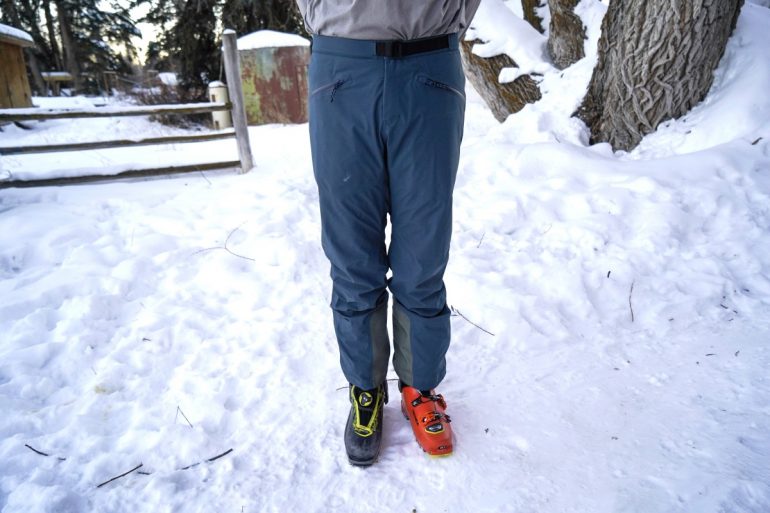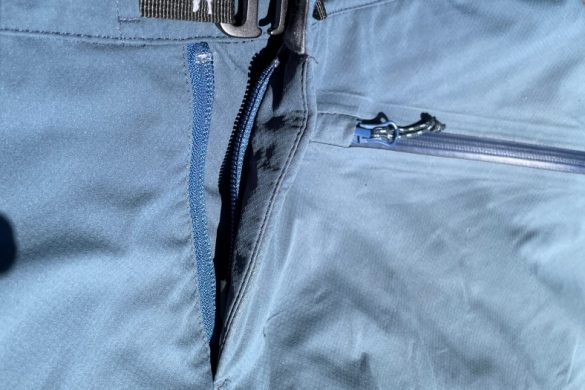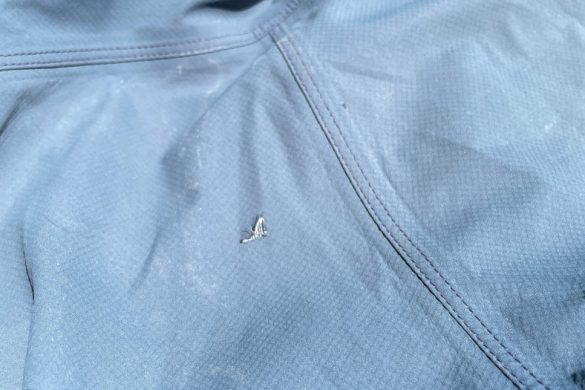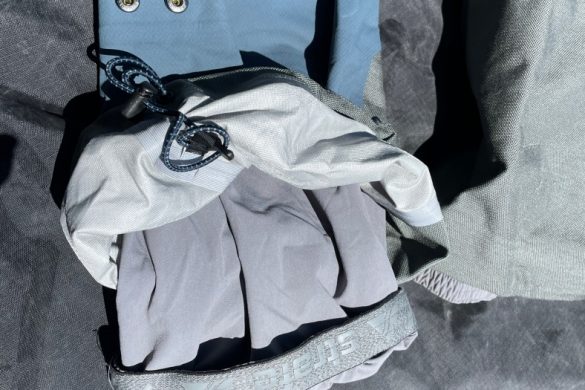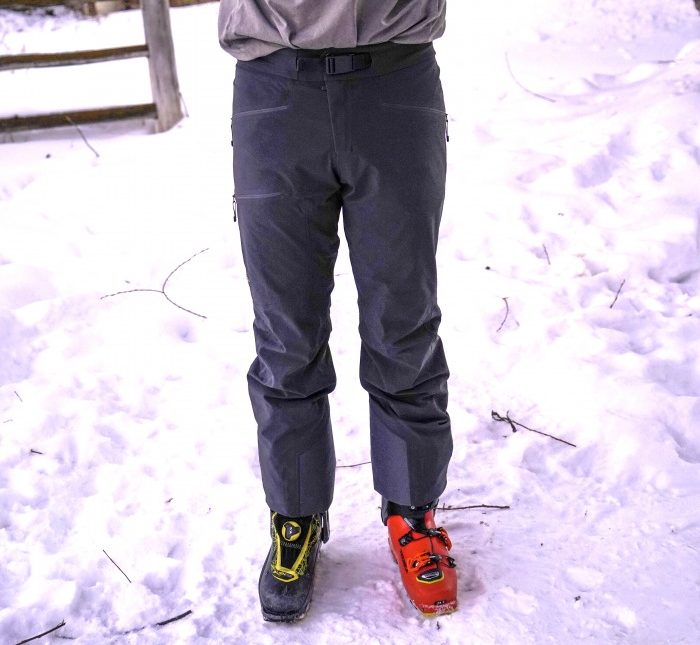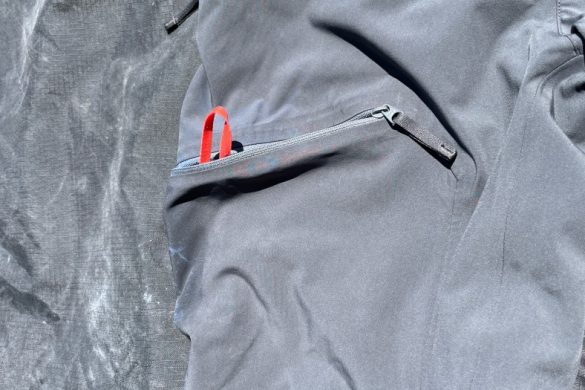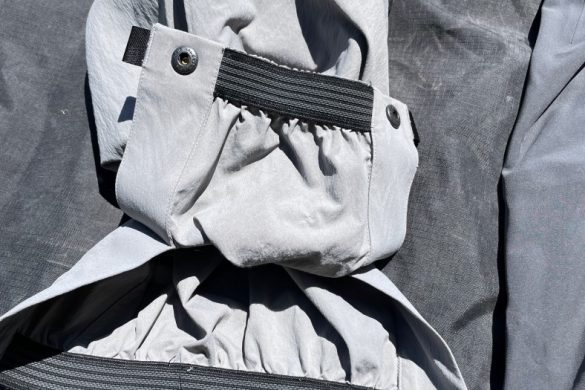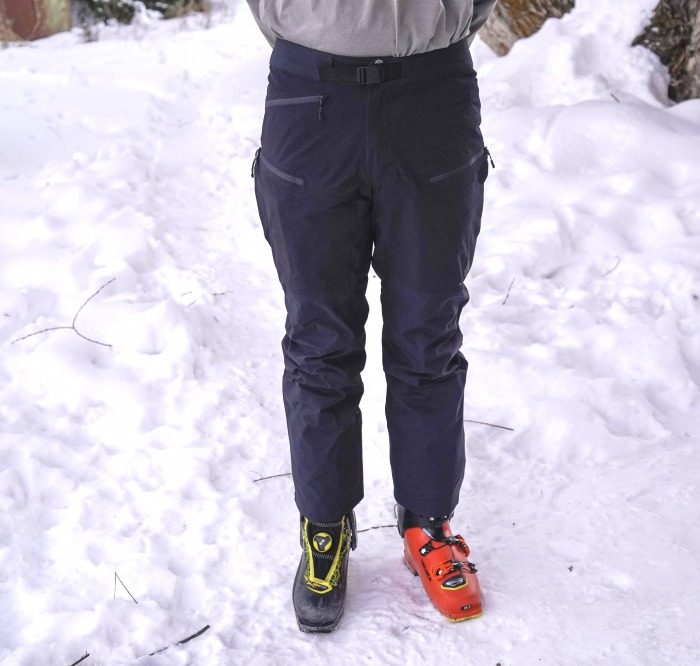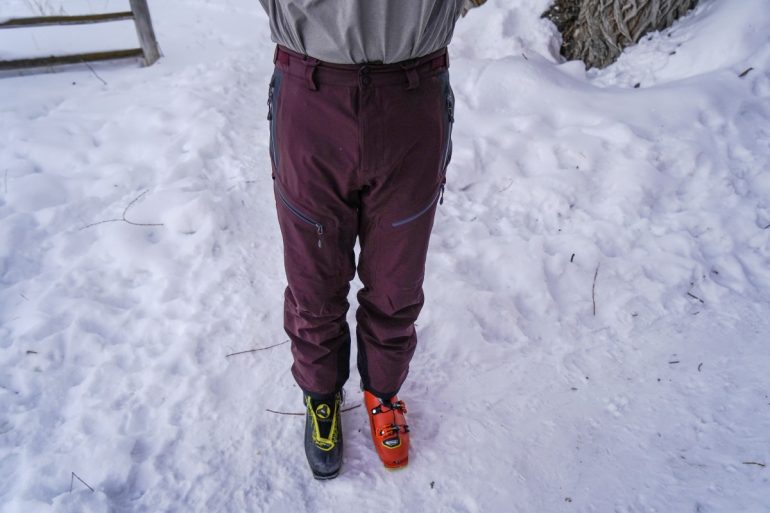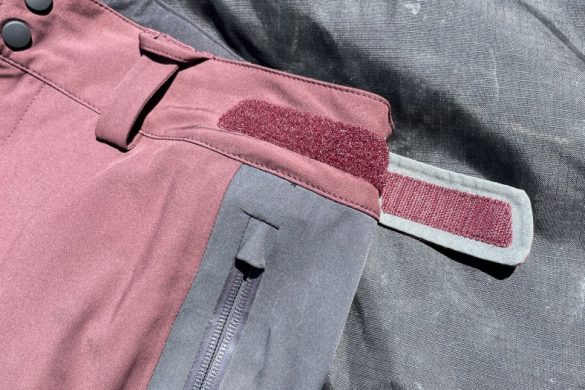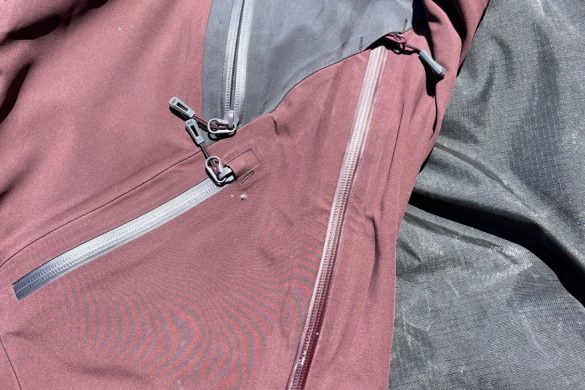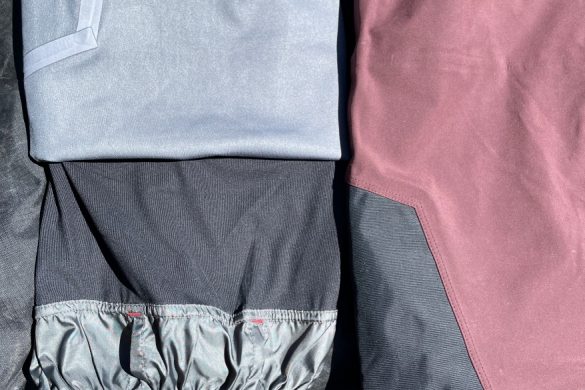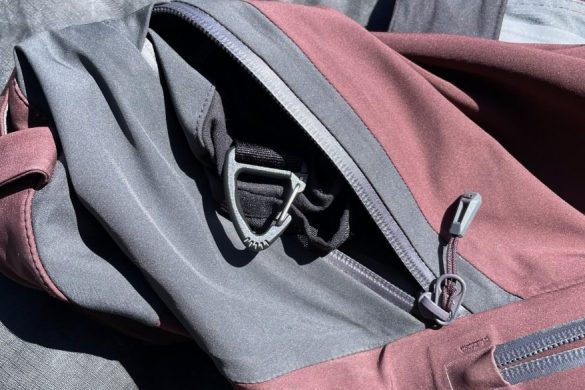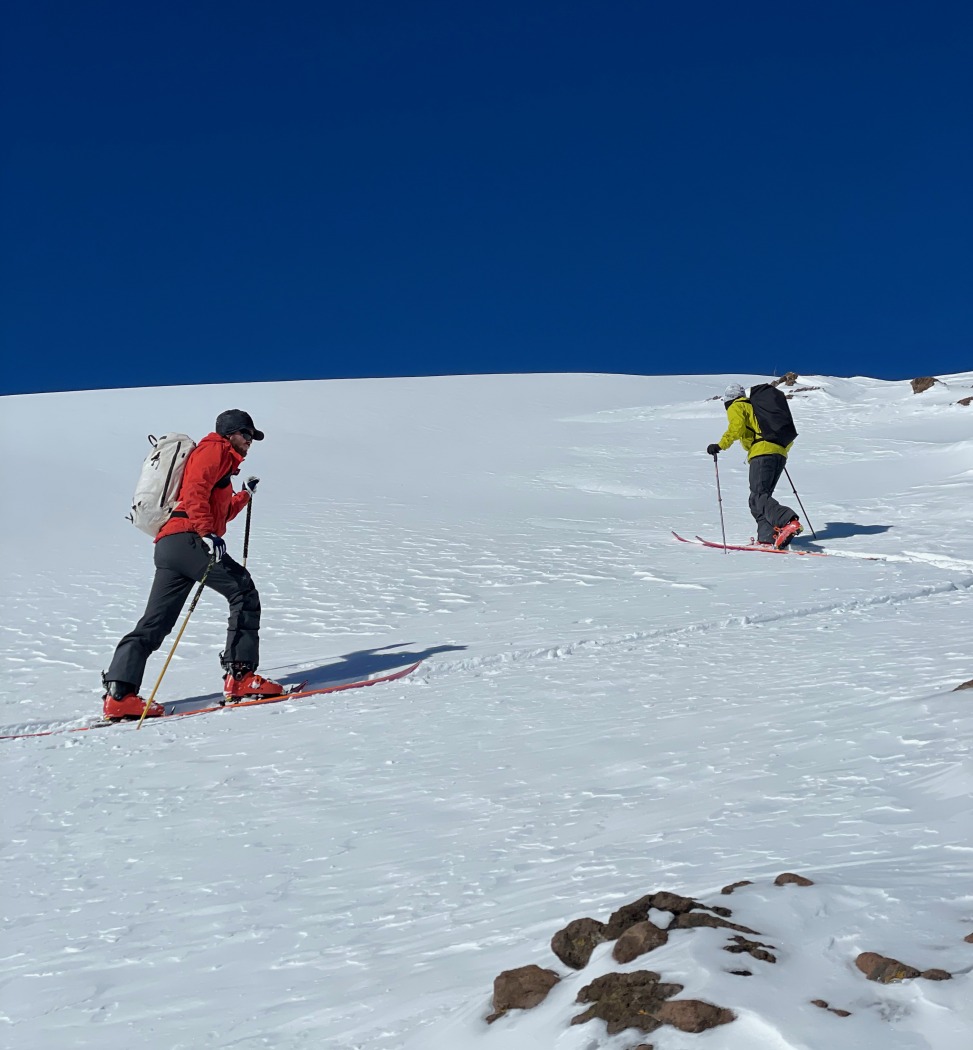
Hardish shell pant testing in the Tetons. All four pants in this review provide a combination of breathability and weatherproofness.
At long last, we are revisiting the first look we posted back in February. I spent the winter rotating through all these pants to get the best possible picture of the pros and cons of each model. With only so many days in winter, I wouldn’t say that I was able to put any one model through the wringer. Still, I was able to get a good sense of performance, form an opinion on the features, and confirm that there weren’t any glaring durability issues. While a few models stood out as especially good for me, all four models had good attributes and will be a good option for someone.
There were a few requests in the comments for additions to the review pool that I wanted to address. Mostly, the scope of this test is “hard-ish” shell pants – In my opinion, this is the most interesting market segment of the last few years as the options have exploded and the fabrics are quite different between brands/models.
The blend of a soft hand and stretch with excellent water resistance/proofing and breathability is somewhat new and, in my mind, exciting. Adding a true softshell to the test shows one end of the breathability/weather resistance spectrum (more breathable, less weather resistant. Adding a Gore-tex Pro pant to the mix offers the other end of the spectrum (very poor breathability, excellent weatherproofing). All of the models below fall somewhere in the middle of the spectrum. It would be cool to have access to a breathability/water column testing rig, but for the sake of real-world performance, knowing where on the spectrum each model falls seems sufficient.
Strafe Cham
Price: $469
Weight: 472g (1lb 0.6oz)
Fabric:
The Schoeller Aerobrane fabric of the Cham pants is my favorite of the test. It is soft and stretchy like the best softshell fabrics, but has good enough waterproofing and never wetted out on me in wet snow or on storm days. The Cham is silent while walking – forget the swish and crinkle of Gore-Tex. Qualitatively, the Cham felt the most breathable of all the models tested. I rarely used the zip vents and stayed dry and comfortable even at high exertion levels on spring days. In cold and windy conditions, the lack of windproofing was apparent. I stayed warm while touring at a good pace but wouldn’t choose these for resort skiing or lower output days of guiding.
Fit: As a devoted fan of Colin Haley and his gear musings (Colin Haley Clothing Systems), I have been moving more and more toward baggier pants that don’t inhibit my movement. The theory here is that even with woven-in mechanical stretch, energy is wasted engaging that stretch and can add up over a long day of skiing/climbing. The Cham has, for me, a near-perfect balance of bagginess without feeling frumpy. The cuffs fit any boot without looking like an overstuffed bratwurst. The waist felt a little big for the size (Medium), and the belt/daisy chain didn’t snug up quite enough for my size 32 waist. This was an easy fix with a sewing machine; I shortened the belt by a few inches and quickly solved my issue.
Features: The daisy chain/hook and snap waist belt are quite low profile and worked great once I shortened the belt. An adjustable G-hook could have been nice here. As for pockets, my ergonomic preference is for thigh pockets rather than hip pockets. They work a bit better with a harness and make my transceiver easier to access/put away. The right hip pocket has a sleeve and clip-in point that works pretty well for a transceiver, but I found it challenging to put my transceiver back into the sleeve, especially with bigger gloves on. I was a bit worried that the vent on the back of the leg (rather than the side on most pants) would be uncomfortable with the bottom of the zipper hitting just below my knee. In practice, it never bothered me, and I appreciated the orientation when I forgot to close them up before some deep wallowing. The back of the leg orientation kept my pants from filling with snow immediately. I can’t say that I utilized the tightening snaps on the back of the calf, however, they also never got in the way. The PU-coated, water-resistant zippers probably improve the weatherproofing in really wet conditions but detract some from the useability of the pockets/vents; they have much more resistance than an uncoated zipper.
Overall: These were my favorite pants on the test. The minimal feature set, incredible fabric, and good fit give the Cham a lightweight feel that has only been matched by my old favorite TNF L5 LT pants. Unlike the TNF pants, the Cham held up well over quite a lot of skiing this season. There was some pilling on the thighs but no tears, cuts, or other damage. They are still beading water pretty well, and they feel well-built and substantial relative to their weight.
Arc’teryx Procline
Price: $399
Weight: 649g (1lb 6.8oz)
Fabric: My understanding is that Infinium is a rebrand of Gore-Tex’s old Windstopper membrane. While the Proclines are lighter and stretchier than some heavy, fleece-backed Windstopper soft shells of times past, the Infinium fabric feels substantial and felt the least breathable of the pants in this test. They still out-breath my older GoreTex Pro hard shells, but they can’t really compete with some of the air-permeable membranes like Aerobrane and Ascentshell. The flip side of this is that the Proclines blocked wind well and felt like the warmest option in the test. I chose these for lower intensity days, cold and blustery days, and they even kept me warm for some frigid evening laps at Snow King. I often used the zippered vents on warmer days and higher intensity tours, as they got hot and clammy at higher outputs. The Infinium fabric has a bit of stretch and is relatively quiet. It is a bit stiffer than Schoeller Aerobrane, and the tightly woven face feels bomber.
Fit: As I’ve come to expect with Arc’teryx, the Procline’s fit is excellent. They are slim without being restrictive and have plenty of space in the cuffs for an opened-up Technica Zero G. The waist and hips are fairly snug for the size – I would recommend sizing up if you are between sizes.
Features: The waist is low profile with a two-snap/zip fly and a built-in belt with a low profile plastic buckle. The snug fit through the hips makes the hip pockets a bit tight to get in and out of, but the thigh pocket has a transceiver clip in, but no sleeve to keep a transceiver oriented, which was sometimes a bit annoying as it moved and flipped around in the pocket. A sleeve would have made this transceiver pocket perfect for me. The thigh vents worked well and have dual zips, which can be nice for bootpacking and fine tuning the venting. Of note, these use non-water resistant zippers for the pockets and vents – this greatly reduces the resistance of opening/closing and is likely more durable in the long run.
Overall: I can’t help but feel like the choice to use Infinium fabric in this piece is more a function of Arc’teryx’s marriage with Gore-Tex rather than the best material for the job. A blend of the fit and features of the Procline, made with Schoeller Aerobrane, or another of the new super breathable and stretchy membrane fabrics would be a real winner. These were my go-to for most guiding, and many of the coldest days this winter. They are showing very little wear and tear. I bet they will last many seasons to come.
Buy the Arc’teryx Procline pant.
BD Dawn Patrol Hybrid
Price: $300
Weight: 564g (1lb 3.9oz)
Fabric: The combo of BD.dry 3 layer and softshell strikes a good balance of waterproofing and stretch/breathability. The hybrid design feels a bit outclassed by the newer generation of super breathable and stretchy waterproof breathable that toe the hard/softshell line in a fashion that achieves near “best of both worlds” performance. I sometimes wondered how BD chose where to place the hardshell panels – for example, the front of the thighs have softshell and would get wet and cold in wet snow. Both the hard and soft shell fabrics feel decent, perhaps generic.
Fit: The pant’s silhouette is a bit funky for me but may work well for folks with larger thighs. For my chicken legs, the hips, thighs, and knee area felt quite baggy – something accentuated by the gusseted pockets. The lower legs taper to a tighter cuff that frequently resembled an overstuffed sausage casing while touring with my Zero G boots fully opened.
Features: With a similar built-in belt and snap/zipper fly to the Arc’Teryx pants, they use a smaller zipper and pull tab, which is a bit challenging to engage with bigger gloves. Despite their baggy appearances, the gusseted thigh pockets functioned well. I carry my transceiver, a scraper, and an ECT cord in my right thigh pocket, and everything fits well without restricting motion or feeling overstuffed. The “pieps pocket” with a padded sleeve and clip was my favorite transceiver pocket; it fit my Barryvox and held it in a comfortable and protected orientation. I thought the padding in the sleeve would feel obtrusive, but it wasn’t noticeable once the transceiver was in the sleeve. I would probably remove the sleeve if I were a harness user, as it adds bulk/weight to the pants. As an infrequent thigh vent user, the single zip slider on the thigh vent worked for me, but it doesn’t allow for the same fine-tuning as the dual zips on the Arc’Teryx and OR options. They are the only pants in the review with a zipper on the cuff, which I generally find unnecessary. It is a terrible way to adjust for different boot cuffs (especially without a gusset behind the zipper).
Overall: I’ll say this – once I had my obligatory 10-15 days in various conditions in these pants, I didn’t continue to reach for them when I had the option of every other pant in the review. It’s hard to pin down why, because there aren’t any major flaws or dealbreakers. They just don’t feel quite as refined as some of the other options, and I never found a niche where they were the best. I would recommend these pants for someone on a budget and looking for more backcountry pants than the OR Skyward below.
Buy the BD Dawn Patrol Hybrid Pant.
OR Skyward 2
Price: $299
Weight: 620g (1lb 5.8 oz)
Fabric: The OR Ascentshell fabric is really excellent. To my understanding, it uses electrospun membrane technology similar to TNF Futurelight and Polartec Neoshell. It is stretchy, feels substantial both in use and in hand, and breathes better than expected. If OR made pants in this fabric with a more minimal feature set, it would be a strong contender for my favorite of the bunch. The DWR seemed to hold up well and rejuvenate nicely with a wash and a few minutes in a warm dryer. I’m not someone who shreds ski pant cuffs, but for those that are, the reinforcement patch all the way around the hem is a nice touch.
Fit: My body type hasn’t generally fit OR pants very well in the past; these are no exception. The fit is likely a huge win for those with larger thighs/leg muscles that don’t fit well in the typical tall and skinny euro fits. Yet, the fit of the Skyward is perfectly acceptable for me and doesn’t have any odd quirks like the tight cuffs of the BD Dawn Patrols. Despite the Strafe Cham also being baggy, the fit/feel is different due to the fabric’s drape and how substantial some of the features on the Skyward feel. It isn’t the Cham’s flowy “freeride” feel; it’s more of a loose-fitting suit of armor.
Features: The waist system feels a little overbuilt and clunky with velcro adjusters rather than the more elegant belts on the other pants. I really like the vertical zip hip pockets. They feel much easier to get a hand into than the horizontal zips found on all the other options. One caveat, the vertical zip pocket is challenging to get a transceiver in and out of, and the right hip pocket is home to the “electronics sleeve” and clip-in point. I wish they would move this to a hip pocket for much easier access and slightly improved comfort. In general, the features feel overbuilt relative to the other pants – the vents have an internal storm flap and built-in garages, all pockets have zipper garages, and all the zippers are of the YKK #5 water-resistant variety (same as Strafe Cham). The cuffs are simple, and the full hem reinforcement is a nice touch. One perplexing feature of the cuffs is the internal powder gaiter which is connected to the pants with a fine, stretchy mesh. This construction isn’t in line with the overbuilt nature of the rest of the pants, and though I never noticed it, it seems like a weak point for snow/water to get in while bootpacking/powder skiing.
Overall: The Skyward is probably the best value in the test. They have an excellent fabric, paired with a longevity-minded design and great versatility. I would recommend these as an awesome 50/50 option for folks that want one pair of pants that perform well in the resort and backcountry. I imagine these will hold up nearly as well as a Gore-tex Pro pant in the resort but perform substantially better in terms of breathability and crinkly-ness while skinning. After ~20 days of use, they show essentially no signs of wear and tear. I imagine they will last many seasons to come.
Buy the Outdoor Research Skyward 2 pants.
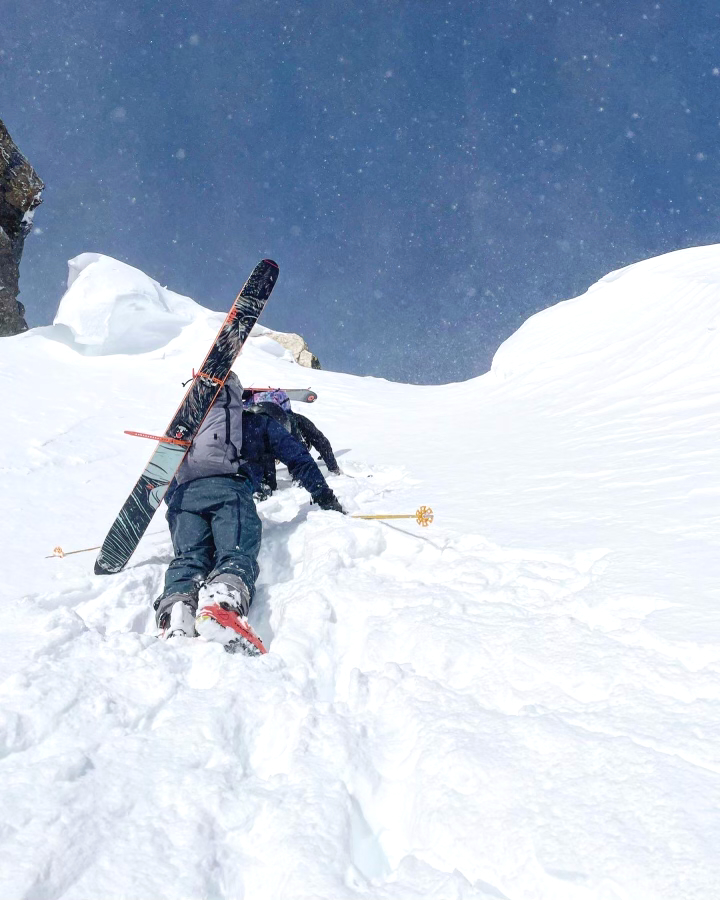
Booting up in the Strafe Cham ski pant. The Schoeller Aerobrane fabric of the Cham pants is my favorite of the test. It is soft and stretchy like the best softshell fabrics, but has good enough waterproofing and never wetted out on me in wet snow or on storm days.
Conclusion:
It doesn’t feel fair to declare a winner among these pants. The fit and features are too personal for me to declare that one option is best for everyone. As a high-output recreational skier, the Strafe Cham stands out as a personal favorite, while in my role as a guide, the Arc’teryx Procline and OR Skyward stood out as long-lasting and high-performing options. I think this “hard-ish shell” category is a big step up in performance and comfort, and I highly recommend getting a hands-on feel of some of these excellent fabrics if you haven’t already.
Gavin is a mountain guide and gear fanatic based in Jackson, WY. His endless pursuit of gear perfection led to starting a pack company, Apocalypse Equipment in 2019. He has a degree in Nordic skiing and mechanical engineering from the University of New Hampshire and worked as a ski shop tech prior to getting his dream job as a WildSnow contributor.

